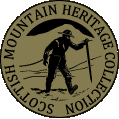
The Scottish Mountain Heritage Collection
Objects Database
Skyhooks
Accession Number
1298.2016.1(a-b)
Object Name
Skyhooks
Created
12/01/2016
Creator
Hermione Cooper
Accession Date
12/01/2016
Brief Description
Two 'J' shaped skyhooks
Dimensions
a-11.5(L)x5(W) cms b- 8.5(L) x3.5(W) cms
Number Of Objects
2
Inscription Description
On a "LEEPER" On b V"
Colour
a-silver b-black
Maker
a- Leeper b-
Object Production Place
USA
Provenance
Artificial climbing is the technique of scaling a rock face using just about everything other than your hands and feet. The most common way of doing it is to bang a piton into a crack, clip a karabiner into it and use it for a handhold. Small ladders which are known as etriers are also clipped and stood on/in. If the rockface is totally blank, on glaciated slabs for instance, holes can be drilled and expansion bolts used to create anchors.
Shyhooks are another, rather scary, method of making progress and involve hooking the device onto a tiny ledge, clipping your etrier into it, and saying a little prayer brfore standing on it! They can be used in various other ways...all equally scary.
Though used in the UK, Skyhooks are pretty much an American thing, having been developed during the early ascents of the big wall climbs of Yosemite in California during the 1960's.
They come with exotic names like Logans, Birdbeaks and Cliffhangers, hooking onto crystals, nubbins and rugositirs! There must be a poem somewhere amongst that lot.
Americans called Jim Logan, Ed Leeper and Yvon Chouinard were amongst the inventors and we have a couple of fine examples of their creations here in the collection.
Acquisition Method
donated by Art McCarthy
Acquisition Date
12/01/2016
Condition Check Date
12/01/2016
Rules
Spectrum : UK Museum documentation standard, V.3.1 2007
Modified
12/01/2016
Related Items
Chouinard Talon
Etrier - (rope & wood ladders)
Sky hook
Skyhooks
